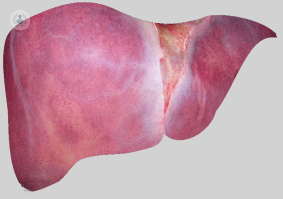What is TACE?
Escrito por:There are on average 16 new cases of liver cancer every day in the UK, and the risk increases the older we get. However, there are a variety of treatments that can help, and while we’ve all heard of chemotherapy, one treatment that is less well known is TACE (transarterial chemo-embolisation). We asked top clinical and interventional radiologist Dr Julian Hague to explain this liver cancer treatment.

What is liver chemo-embolization?
Transarterial chemo-embolization (TACE) is a way of delivering high dose chemotherapy to the liver, through the arteries.
Some types of liver tumour are very difficult to treat with normal chemotherapy tablets or injections. In certain circumstances, these types of tumour can be treated by placing a fine catheter or tube into the main artery in the top of the thigh and then directing it into the artery to the liver. This is done using X-rays to guide the catheter, and is often done under local anaesthetic or light sedation.
How does the TACE procedure work?
Once the catheter is in place, which usually takes a few minutes, the blood vessel to the tumour is injected with tiny particles (like grains of sand). These can be coated in high dose chemotherapy. The effect of this is that very high doses of chemotherapy are given to the tumour, whilst the particles lock the treatment into the tumour, preventing the chemotherapy from escaping into the general circulation where it may cause damage to other organs.
Often, patients will need to stay for one night in hospital after this procedure. It can be repeated if necessary. Most patients will recover very quickly and return to normal activities in a week or so.
Can TACE cure liver cancer?
It is very rare for TACE procedures alone to be able to cure liver cancer. However, in certain cases, it may be possible to reduce the tumours to an extent where other treatments, such as surgery, become possible. Unfortunately, most of the time, these liver-directed treatments are used when normal chemotherapy is not working and a cure is not possible.
TACE (transarterial chemo-embolisation), also known as drug-eluting bead chemo-embolisation, has been found to be effective for tumours such as hepatocellular carcinoma and colorectal liver metastases. Your oncologist or hepatologist will be able to discuss these treatments with you.



